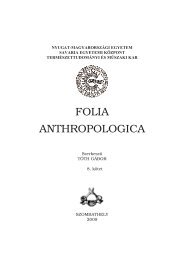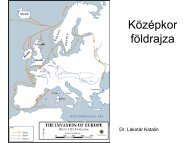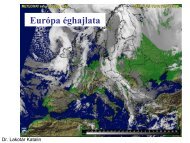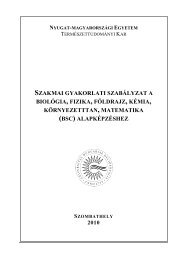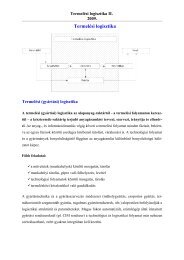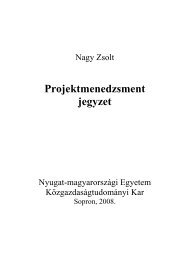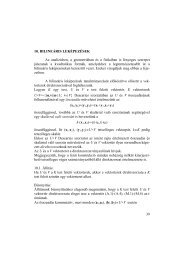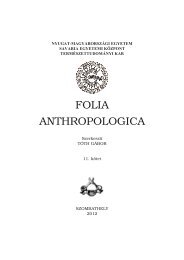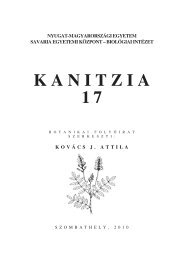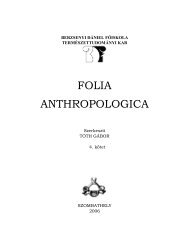Kanitzia 18. - NYME Természettudományi Kar - Nyugat ...
Kanitzia 18. - NYME Természettudományi Kar - Nyugat ...
Kanitzia 18. - NYME Természettudományi Kar - Nyugat ...
You also want an ePaper? Increase the reach of your titles
YUMPU automatically turns print PDFs into web optimized ePapers that Google loves.
warming up-drying up processes, inducing subdesert-like microclimate and local steppe<br />
conditions of the very dry slopes and landslides developed on sandy and marly substrates<br />
of southern expositions.<br />
The vegetation physiognomy present an open-loosed structure, the general cover<br />
having cca 65-85%, realized preponderant by the two characteristic species (K. ceratoides,<br />
A. cristatum). The coenotic composition of the plant community is well defined by the diagnostic<br />
species group: Artemisia campestris agg., A. pontica, Brassica elongata, Stipa lessingiana,<br />
Artemisia austriaca, Astragalus monspessulanus, Cephalaria uralensis<br />
(Artemisio-Kochion s.l., Festucion rupicolae). The species composition contains a diversity<br />
of xerothermic elements, from which some present good constancy values (III-V): Elymus<br />
hispidus, Astragalus austriacus, Phlomis tuberosa, Jurinea mollis, Festuca rupicola (Festucetalia<br />
valesiacae), Salvia nemorosa, Euphorbia cyparissias, Poa angustifolia, Koeleria<br />
cristata (Festuco-Brometea). Other species considered as xerothermic generalists participate<br />
in the vegetation structures with a medium frequency values (Vinca herbacea, Nepeta nuda,<br />
Linum austriacum, Scabiosa ochroleuca, Medicago falcata, Asparagus officinalis etc.).<br />
The stands of Agropyron cristatum-Krascheninnikovia ceratoides present a relatively<br />
well balanced vegetation unite, because their coenotic structure are permanently supplemented<br />
with various xerothermic species from the neighboured steppic and dry<br />
grasslands (Stipetum pulcherrimae, Stipetum lessingianae, Stipetum capillatae, Bothriochloetum<br />
ischaemi, Carici humilis-Festucetum rupicolae) (Vultureni, Groapa, Poiana).<br />
Even if the species immigration is a long process, it can be remarked for all relevés analysed<br />
the absence of some genuine steppe elements like: Crambe tataria, Salvia nutans, S. transsylvanica,<br />
Echium maculatum, Ajuga laxmannii, Astragalus excapus subsp. transsylvanicus<br />
etc. Instead of these, actually the weeds and weed-like species can be spreading more:<br />
Calamagrostis epigeios, Melilotus officinalis, Daucus carota, Elymus repens, Ballota nigra,<br />
Artemisia vulgaris, Carduus acanthoides etc.The coenotic relations with the fringe communities<br />
and the semi-dry grassalnds is indicated by the presence of Dorycnium<br />
herbaceum, Brachypodium pinnatum, Galium glaucum etc. The dendrogram of the cluster<br />
analysis of the sampled plots (Fig. 5.) shows that the relevés are separated in a specific<br />
group, are in coenological relationships with the next two groups of the Potentillo arenaiae-Stipetum<br />
capillatae and the Bothriochoetum ischaemi communities plots. The distance<br />
between the relevés (1-10) signed also their separation and fragmentation in relation<br />
with the specific field and ecological conditions. The ordination diagramm (Fig. 6.) obtained<br />
by the principal component analysis expressed this fragmentation also.<br />
The stands dominated by K. ceratoides in Transylvania after the actual coenological<br />
structure, species composition and peculiar habitat characteristics constitute a distinct<br />
plant community with transitional characteristics between the Artemisio-Kochion s. l. and<br />
Festucion rupicolae alliances. We described them as a new plant community named<br />
Agropyro cristati-Krascheninnikovietum ceratoidis ass. nova (Table 1, typus relevé 7). The<br />
new association has coenotic and ecologic relationships with the Artemisietum ponticocampestris<br />
SOÓ 1947 (Transylvanian Basin) and with the Agropyro cristati-Kochietum<br />
prostratae ZÓLYOMI 1958 (Pannonian Basin). The new xerothermic plant community is<br />
70




